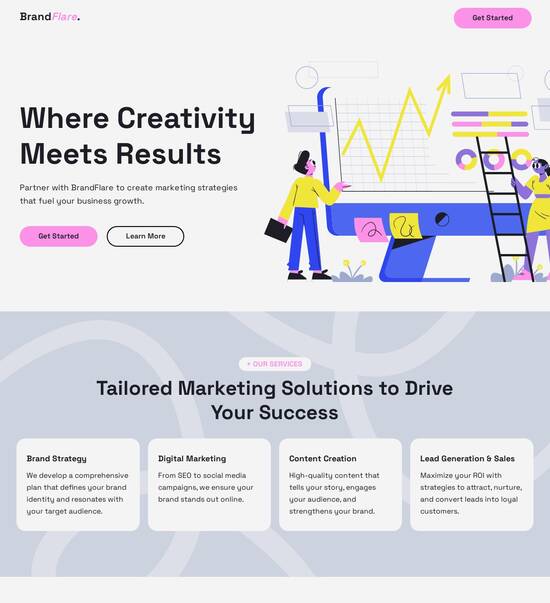
HTML page template for emergency response teams
Use TemplateAbout template
Collaborate and optimize like never before with our landing page templates for emergency response teams. Ready to streamline your workflow?
Recommended templates

Easy to build without coding
With the intuitive drag-and-drop builder, anyone on your team can create high-converting pages without any knowledge of code or design. Make enhancements to your landing page with custom widgets using Javascript, HTML/CSS, or third-party scripts.

Multiple layouts for any industry and goal
Select from 500+ landing page layouts built to boost conversions across industry-specific scenarios. Customize them by adjusting fonts, adding images, and generating on-brand content with the AI assistant. Quickly scale with Instablocks® and Global Blocks that you can save, reuse, and update globally.

Loads fast and looks polished on any device
Every template is responsive, which means they present professionally on any device and load blazingly fast with our Thor Render Engine. You can also power them up with Google AMP technology to deliver an unparalleled mobile experience and drive higher conversions.

Robust analytics & experimentation
Get real-time updates and reporting across all your devices, showing the number of visitors, conversions, cost-per-visitor, and cost-per-lead. Launch AI-powered experiments, run A/B tests, and use heatmaps to analyze user behavior, then optimize your landing page to maximize conversions.







Easy to build without coding
With the intuitive drag-and-drop builder, anyone on your team can create high-converting pages without any knowledge of code or design. Make enhancements to your landing page with custom widgets using Javascript, HTML/CSS, or third-party scripts.
Multiple layouts for any industry and goal
Select from 500+ landing page layouts built to boost conversions across industry-specific scenarios. Customize them by adjusting fonts, adding images, and generating on-brand content with the AI assistant. Quickly scale with Instablocks® and Global Blocks that you can save, reuse, and update globally.
Loads fast and looks polished on any device
Every template is responsive, which means they present professionally on any device and load blazingly fast with our Thor Render Engine.
Robust analytics & experimentation
Get real-time updates and reporting across all your devices, showing the number of visitors, conversions, cost-per-visitor, and cost-per-lead. Launch AI-powered experiments, run A/B tests, and use heatmaps to analyze user behavior, then optimize your landing page to maximize conversions.
All the features you need to build lead-generating landing pages
Explore more featuresLearn how to build top-performing landing pages for any goal
FAQs
Leading the way in building high-performing landing pages





A comprehensive guide on optimizing your landing pages with Instapage
The effective execution of digital marketing campaigns heavily relies on the capabilities of a powerful landing page and conversion rate optimization (CRO) platform like Instapage. With its diverse tools and features, such as pre-built templates and detailed analytics, you can significantly enhance your marketing efforts. In this guide, we'll walk you through a step-by-step process to maximize your return on investment (ROI) with Instapage, catering specifically to marketers across various industries, including tech, education, and financial services.
Understanding the fundamentals of landing pages
Landing pages serve as the focal point of your digital marketing strategy. They can either make or break a campaign. Instapage enables marketers to create tailored pages quickly and easily. This flexibility is essential, especially for teams in sectors like marketing and advertising who need to adapt rapidly to changing audience needs.
- Utilization of high-converting templates: Instapage offers a library of over 100 templates designed to maximize conversions.
- Easy integration of lead generation elements: Pre-built forms and call-to-action (CTA) buttons streamline the process of capturing leads.
- Customization options: Tailor every detail of your landing pages to reflect your brand identity and campaign goals.
Step 1: Building your landing page
Creating your first landing page is straightforward with Instapage's intuitive drag-and-drop builder. Start by choosing a template that aligns with your campaign's objectives.
- Select a template that fits your marketing vertical, such as tech or education.
- Utilize Instablocks to add sections quickly, ensuring a cohesive design.
- Preview your page in real-time to assess how it will appear to visitors.
Step 2: Optimizing for conversions
Once your landing page is built, the next step is optimization. Leverage Instapage's built-in experimentation tools.
- Conduct A/B tests to evaluate which variations of your page drive more conversions.
- Use heatmaps to analyze on-page behavior and adjust elements accordingly.
- Review performance analytics to refine strategies based on visitor data.
Step 3: Personalizing the user experience
Enhancing the user experience through personalization is crucial. Instapage allows for dynamic text replacement and audience-specific metrics tracking.
- Implement dynamic text to match your ads with corresponding landing pages automatically.
- Align your content with the needs of distinct audience segments.
- Utilize data tools to gather insights on audience interactions, fostering deeper engagement.
By implementing these steps, marketers can effectively leverage Instapage to boost campaign ROI.
Ready to elevate your digital marketing success? Sign up for Instapage today and transform your landing page strategy.
People also ask about HTML page template for emergency response teams
HTML page template for emergency response teams
Understanding the need for robust HTML templates in emergency response
Emergencies can strike at any moment, and the ability to respond quickly and effectively is crucial for minimizing impact. The importance of preparedness in emergencies cannot be overstated, as it directly influences the outcomes during real crises. Given the evolving landscape of technology, robust HTML templates for emergency response teams hold immense value in disseminating critical information promptly and efficiently.
Technology plays a pivotal role in modern emergency management by providing real-time information to teams and the public. For instance, during hurricane events, web templates can be tailored to show weather updates, evacuation notices, and resource availability. Case studies such as the successful deployment of web templates during Hurricane Harvey showcase how effective communication can enhance operational response and public safety. These templates serve not only as communication tools but also as essential resources for coordination among different stakeholders.
Defining the target audience
The primary users of HTML templates in emergency response are the emergency response teams themselves. These teams operate in a fast-paced environment where their communication channels must be direct and effective. It's paramount for these groups to have access to templates that allow for immediate updates and information sharing among all members of the team.
Beyond the teams on the ground are the various stakeholders involved in emergency management, including local governments, first responders, NGOs, and the community. Each group relies on accurate and timely information during a crisis. Therefore, considering the diverse audience when crafting HTML templates is crucial. Communication strategies need to be segmented to meet the varied needs of these groups, ensuring that everyone is on the same page.
Core features of an effective HTML page template
An effective HTML page template for emergency response must prioritize responsive design, enabling accessibility across various devices. During emergencies, many individuals rely on mobile devices for information. Thus, designers should ensure that web layouts adapt seamlessly to different screen sizes, maintaining a clear and user-friendly interface.
Mobile compatibility: Templates must adapt to smartphones, tablets, and desktops.
Visual hierarchy: Use fonts, colors, and layout to guide users naturally through the content.
Multi-device testing: Templates should be tested on various devices to ensure consistency.
Customizable layouts are another critical feature that allows emergency teams to communicate effectively during various situational needs. For example, an emergency template could include sections for urgent announcements, alerts, and resources such as contact information for local shelters. The flexibility of the design enables it to be adapted to different types of emergencies, whether natural disasters, health crises, or community alerts.
Technical components essential for implementation
To enhance the user experience with real-time updates, incorporating various technical components into HTML templates is essential. Utilizing `document.addEventListener` is one approach to facilitate this functionality, allowing the templates to respond to changes in data dynamically. By implementing best practices for integrating event listeners, emergency teams can ensure that information is updated without delay, thereby improving situational awareness.
`DOMContentLoaded` is another critical aspect that influences how quickly a template loads. The significance of loading sequences is amplified during emergencies when time is of the essence. Using `DOMContentLoaded` allows important content to render before images and other less critical resources, ensuring that users see vital information without delay.
Use JavaScript to manage real-time updates through event listeners effectively.
Optimize loading sequences to prioritize crucial emergency information.
Incorporate multimedia elements to enhance engagement and convey messages efficiently.
Implementing accessibility features
In addition to being informative and engaging, HTML templates must adhere to Web Content Accessibility Guidelines (WCAG). Ensuring templates are usable by all individuals, including those with disabilities, is of utmost importance during emergencies. By prioritizing accessibility, emergency response teams can guarantee that vital information is available to everyone.
Examples of accessible design practices include adding alt text to images, enabling keyboard navigation, and ensuring contrast ratios are sufficient for legibility. Organizations should invest time in understanding and applying these practices to create templates that serve the entire community effectively.
Incorporate alt texts for images to aid visually impaired users.
Ensure navigation can be accomplished via keyboard shortcuts.
Design templates with high color contrast for readability.
Creating content that captivates and informs
When emergencies arise, the effectiveness of communication hinges on clarity and conciseness. Crafting clear and concise messaging is paramount to simplifying information delivery in high-stress situations. Using headings, bullet points, and short paragraphs allows the key messages to stand out and be readily understood by the audience.
One effective strategy is to utilize call-out sections for critical information. This can involve visually distinct elements on the page to draw attention to urgent alerts and updates, ensuring these messages are not overlooked. Keeping the design simple yet impactful allows the content to shine through, particularly when every second counts.
Break down information into small, digestible sections.
Highlight critical alerts using contrasting colors or larger text.
Use bullet points for step-by-step instructions or emergency protocols.
Supporting community engagement and support
Incorporating social media feeds into HTML templates can greatly enhance information dissemination. By aggregating local social media content, emergency response teams can provide a comprehensive view of the situation. This enables users to access real-time updates and activities directly from platforms where community members are already engaging.
Furthermore, encouraging community interaction through feedback forms is vital during emergencies. These feedback mechanisms allow the community to express their concerns, ask questions, or provide information that may assist response efforts. Effective designs for these forms should be straightforward, ensuring users can contribute without any barriers, thus fostering a collaborative environment.
Use APIs to effectively pull social media data into templates.
Design feedback forms with simplicity in mind to encourage submissions.
Highlight community contributions on the main page to engage users.
Testing, updating, and maintaining templates
Regular updates to content and features are critical for ensuring that an HTML template remains functional and relevant. Establishing a schedule for updates is essential, as this helps organizations stay prepared when emergencies arise. Templates should include placeholders for information that is likely to change, such as contact details and resource links.
In addition, organizations should look into techniques for automating content updates, allowing teams to focus on other critical tasks. This can involve the use of plugins or scripts that auto-refresh information from designated sources, ensuring users always receive the latest content.
Create an update schedule to keep content fresh and relevant.
Utilize automated tools to minimize manual updates.
Regularly review and revise templates based on user feedback.
Showcasing case studies and success stories
Real-world examples of HTML templates in action can provide invaluable learning opportunities. Numerous successful implementations have demonstrated the positive impact of effective web templates during major emergencies, such as wildfires and public health crises. By examining these case studies, organizations can gain insights into best practices and the measurable benefits of employing robust HTML templates.
Notably, during the COVID-19 pandemic, many local governments adopted HTML page templates tailored for communication. These templates significantly improved public coordination, as they streamlined the dissemination of vital information regarding safety protocols, testing sites, and available resources. The success of these initiatives underscores the role of technology in enhancing emergency response capabilities.
Conclusion on future prospects for HTML templates in emergency response
The evolving landscape of emergency communication necessitates ongoing adaptation of HTML templates. As technology continues to advance, it is likely that templates will also evolve to meet changing needs and enhance usability. Innovations in web design and user experience are at the forefront of these changes, ultimately allowing emergency response teams to better serve their communities.
Future prospects point towards a greater reliance on data analytics and user feedback mechanisms, which can inform ongoing enhancements to template design. As these templates adapt, they will foster better engagement, trust, and efficiency in emergency response operations, paving the way for improved outcomes and greater community resilience.
Ready to skyrocket conversions?
Supercharge your ad campaigns with high-performing landing pages
Get started














